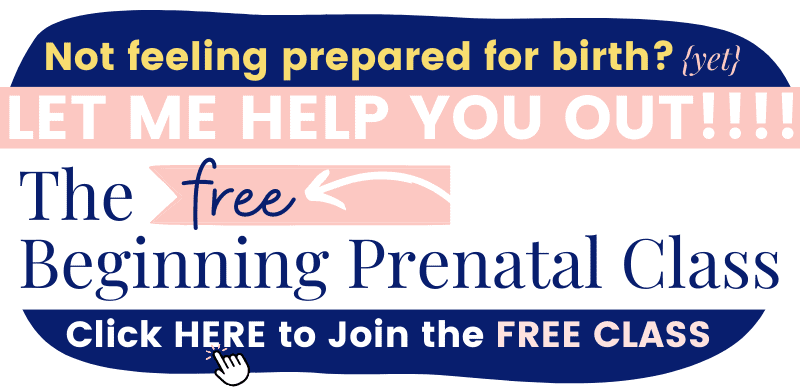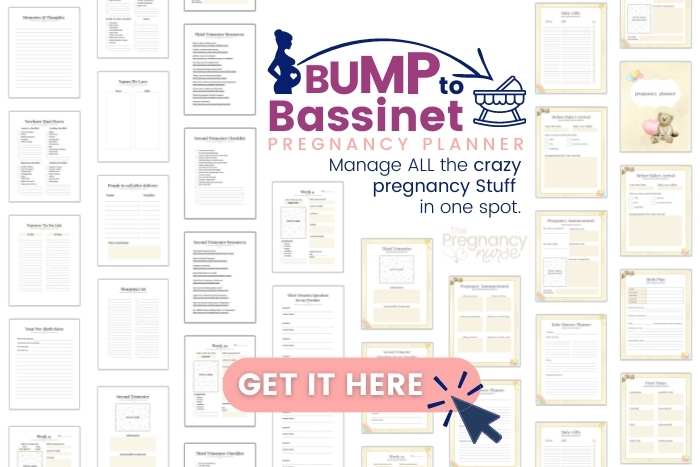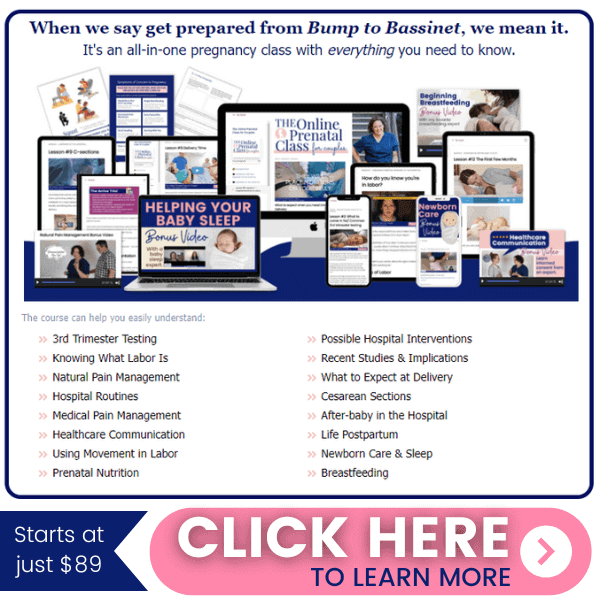This is your pregnancy calendar to know what is going on by your pregnancy week. You will need the first day of your last menstrual period for this pregnancy calculator. We’ll tell you what types of pregnancy tests you’ll need before the delivery date of your baby.
Being pregnant is SO exciting, but it is a whole new world of information. As a pregnant woman you don’t want to miss any important medical information — which is awesome, I am totally here for you!
Hi, I’m Hilary — The Pregnancy Nurse 👩⚕️. I have been a nurse since 1997 and I have 20 years of OB nursing experience, I am also the curly head behind Pulling Curls and The Online Prenatal Class for Couples. 🩺 Follow me for more positive pregnancy & labor tips! 😊
Me and my 20 years of experience are HERE for you during this pregnancy. Come join me as I walk you through my best tips for your pregnancy & delivery (you’ll pick your week of pregnancy so I can give you info tailored JUST for you)
Pregnancy Calculator & Calendar
First off, let’s get you some solid dates. I bet your first question was “when am I going to have this baby?” And that’s SO important. This pregnancy calculator will give you so much awesome general information as you go through your pregnancy stages.
As I said you do need to know the first day of your last period, and then it is going to calculate your gestational age, due date, your # of weeks of pregnancy, and when you should be planning for important tests.
PREGNANCY CALCULATOR
Enter the date of the first day of your last menstrual period (LMP):
DUE DATE RESULT
Probable date of conception:
Foetal Age Today:
Best date range for NT scan:
(12 weeks 3 days to 13 weeks 3 days)
Morphology Scan Date:
(19 weeks)
First Heart Tones by Doppler:
(11 to 12 weeks)
Best time to evaluate cervical length in patient with risk factors:
Best time for routine anatomy ultrasound:
(18 to 20 weeks)
Estimated Due Date:
Please note that ABSOLUTELY NO data from this calculator is kept (which means it also goes away when you leave this page) — here’s a sample of what you’ll learn:
- Probable date of conception
- Fetal Age Today
- Best date range for NT scan (the nuchal translusencey test)
- Morphology Scan Date (when they could check for gender on an ultrasound)
- First Heart Tones by Doppler (when you can be sure that baby has a heartbeat)
- Best time to evaluate cervical length in patient with risk factors
- Best time for routine anatomy ultrasound (usually done at the same time as the other ultrasound mentioned in the US)
- Estimated Due Date
- Today, age of your baby is….
Pretty cool, right?
This pregnancy calendar goes hand in hand with the best pregnancy planner. You can already start marking dates and times you need to remember to do things for your baby!
You’ll notice that pregnancy calculator gives you a ton of information about the stage of pregnancy that you’re in. Once you have a positive pregnancy test (wondering when the best time of day to take a pregnancy test is?) it is important to call your health care provider (or figure out a provider) to get your prenatal care scheduled. Your little bean can use a watchful eye as they grow in your womb.
Pro Tip: Home pregnancy tests are just about as accurate as ones at your doctor’s office and I prefer the dollar store ones because they’re SO cheap (and accurate). I used them myself! {see my “online pregnancy test” here}
It is important to call, but most often providers don’t schedule your first prenatal visit until week 6-12.
As a note, that while the date of your last period can give you a basic week of your pregnancy, many providers like to have an early ultrasound exam to both check for the size of the baby (giving you a better estimated due date) and also for baby’s heartbeat. Your menstrual cycle length may vary from the “average” (I ovulate very late) so that can change things.
Also, remember, that “due date” isn’t an exact due date — it’s an estimated date that is likely off by 1-2 weeks. So, JUST because you get to your due date and baby isn’t born, you could still have a couple of weeks left!
I have a whole post on how weeks of months of pregnancy (and trimesters) in my post: How many weeks is six months of pregnancy.
Ok, let’s quickly go through the trimesters of pregnancy, and what to expect.
First Trimester: Weeks 0-14
Trimesters are counted from the start of your last menstrual period (are you sensing how important that date is). Remember, your fallopian tube doesn’t release an egg (that is later fertilized) until about 2 weeks after that period — so you’re not even actually PREGNANT until week 2 or so, but that’s how we count it.
It is important that you take a prenatal vitamin as soon as you find out you’re pregnant. Actually, all women who have any chance of pregnancy should be taking a prenatal vitamin, as studies have shown that it can prevent issues with the spinal cord development and birth defects.
There are lots of early signs of pregnancy that you could be experiencing, due to changes in the pregnancy hormones in your body. These can include nosebleeds, morning sickness, tenderness of your breasts and more. I outline all of that in my early pregnancy symptoms post.
Second Trimester: Weeks 14-26
At the start of the second trimester, pregnant women tend to start to feel better from the morning sickness. At this stage fetal development is in full gear. You’ll likely see some weight gain and a baby bump will be more pronounced.
You might even start to feel the baby kick and move around 20 weeks. It can be hard since when people feel the baby move is based on a variety of things including where the placenta is on the uterus.
There are a few pregnancy tests you’ll take during this trimester (including the glucose/diabetes test), but it is the most relaxed of all the trimesters. A great time to think of some baby names, or talk over baby showers with friends.
Third Trimester Weeks 27-40+
At the start of your third trimester of pregnancy, your baby is pretty well formed and just growing inside of you. It’s important that you stay very hydrated during this pregnancy (I do have a whole post on if drinking gatorade during pregnancy is OK and all the other fluids you can use to hydrate).
At this point, you may have more testing. Possibly more ultrasounds, or tests like the BPP or checking amniotic fluid levels (that means how much water is in the amniotic sac). Make sure that you keep scheduled appointments with your healthcare provider.
I just did a podcast all about ultrasound testing like BPP:
I actually talk all about these tests in my Free Beginning Prenatal Class that tens of thousands of women have just loved.

Either way, what an EXCITING time of life. Yes, your pregnancy is likely met with many emotions which you will have a good amount of time to deal with as you progress. Make sure you find a good provider, and helpful information like Pulling Curls & the Pregnancy Nurse to help make this journey as easy as possible!









Leave a Reply